what is the closest relative to a giraffe
| Okapi | |
|---|---|
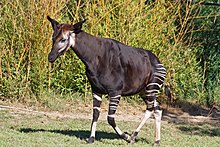 | |
| At Beauval Zoo | |
| Conservation condition | |
| | |
| Scientific classification | |
| Kingdom: | Animalia |
| Phylum: | Chordata |
| Class: | Mammalia |
| Gild: | Artiodactyla |
| Family: | Giraffidae |
| Genus: | Okapia Lankester, 1901 |
| Species: | O. johnstoni |
| Binomial name | |
| Okapia johnstoni (P.L. Sclater, 1901) | |
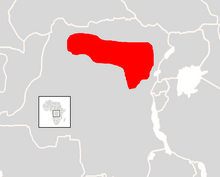 | |
| Range of the okapi | |
The okapi (; Okapia johnstoni), also known as the forest giraffe, Congolese giraffe, or zebra giraffe, is an artiodactyl mammal that is owned to the northeast Autonomous Republic of the Congo in central Africa. Although the okapi has striped markings reminiscent of zebras, it is most closely related to the giraffe. The okapi and the giraffe are the merely living members of the family Giraffidae.
The okapi stands about i.5 m (4.ix ft) alpine at the shoulder and has a typical body length around ii.five m (8.ii ft). Its weight ranges from 200 to 350 kg (440 to 770 lb). Information technology has a long cervix, and large, flexible ears. Its coat is a chocolate to reddish chocolate-brown, much in dissimilarity with the white horizontal stripes and rings on the legs, and white ankles. Male person okapis have short, distinct horn-like protuberances on their heads called ossicones, less than 15 cm (5.9 in) in length. Females possess hair whorls, and ossicones are absent.
Okapis are primarily diurnal, but may exist agile for a few hours in darkness. They are essentially solitary, coming together merely to brood. Okapis are herbivores, feeding on tree leaves and buds, grasses, ferns, fruits, and fungi. Rut in males and oestrus in females does not depend on the season. In captivity, estrus cycles recur every fifteen days. The gestational catamenia is around 440 to 450 days long, following which ordinarily a single calf is born. The juveniles are kept in hiding, and nursing takes place infrequently. Juveniles commencement taking solid food from 3 months, and weaning takes identify at half-dozen months.
Okapis inhabit canopy forests at altitudes of 500–ane,500 1000 (ane,600–4,900 ft). The International Marriage for the Conservation of Nature and Natural Resources classifies the okapi every bit endangered. Major threats include habitat loss due to logging and human settlement. Illegal mining and extensive hunting for bushmeat and skin have also led to a turn down in populations. The Okapi Conservation Project was established in 1987 to protect okapi populations.
Etymology and taxonomy [edit]

Strips cutting from the striped role of the skin of an okapi, sent home by Sir Harry Johnston, were the first evidence of the okapi's existence to achieve Europe
Although the okapi was unknown to the Western world until the 20th century, it may have been depicted since the early fifth century BCE on the façade of the Apadana at Persepolis, a gift from the Ethiopian procession to the Achaemenid kingdom.[ii]
For years, Europeans in Africa had heard of an fauna that they came to call the African unicorn.[3] [4] The beast was brought to prominent European attention by speculation on its being establish in press reports covering Henry Morton Stanley's journeys in 1887. In his travelogue of exploring the Congo, Stanley mentioned a kind of donkey that the natives called the atti, which scholars later on identified as the okapi. Explorers may take seen a fleeting view of the striped backside as the animal fled through the bushes, leading to speculation that the okapi was some sort of rainforest zebra.[ commendation needed ]
When the British special commissioner in Republic of uganda, Sir Harry Johnston, discovered some Pygmy inhabitants of the Congo being abducted by a showman for exhibition, he rescued them and promised to return them to their homes. The Pygmies fed Johnston'southward curiosity about the animate being mentioned in Stanley's book. Johnston was puzzled by the okapi tracks the natives showed him; while he had expected to be on the trail of some sort of forest-abode equus caballus, the tracks were of a cloven-hoofed beast.[5]

Illustration from an original painting by Sir Harry Johnston, based on preserved skins (1901)
Though Johnston did not come across an okapi himself, he did manage to obtain pieces of striped pare and eventually a skull. From this skull, the okapi was correctly classified as a relative of the giraffe; in 1901, the species was formally recognized as Okapia johnstoni.[half-dozen]
Okapia johnstoni was kickoff described equally Equus johnstoni by English zoologist Philip Lutley Sclater in 1901.[vii] The generic name Okapia derives either from the Mbuba name okapi [8] or the related Lese Karo name o'api , while the specific name (johnstoni) is in recognition of Johnston, who offset caused an okapi specimen for science from the Ituri Woods.[6] [9]
In 1901, Sclater presented a painting of the okapi before the Zoological Society of London that depicted its physical features with some clarity. Much confusion arose regarding the taxonomical condition of this newly discovered animal. Sir Harry Johnston himself called it a Helladotherium, or a relative of other extinct giraffids.[10] Based on the clarification of the okapi by Pygmies, who referred to it as a "horse", Sclater named the species Equus johnstoni.[11] Subsequently, zoologist Ray Lankester declared that the okapi represented an unknown genus of the Giraffidae, which he placed in its own genus, Okapia, and assigned the proper noun Okapia johnstoni to the species.[12]
In 1902, Swiss zoologist Charles Immanuel Forsyth Major suggested the inclusion of O. johnstoni in the extinct giraffid subfamily Palaeotraginae. However, the species was placed in its own subfamily Okapiinae, past Swedish palaeontologist Birger Bohlin in 1926,[13] mainly due to the lack of a cingulum, a major characteristic of the palaeotragids.[fourteen] In 1986, Okapia was finally established every bit a sister genus of Giraffa on the basis of cladistic analysis. The two genera together with Palaeotragus constitute the tribe Giraffini.[fifteen]
Evolution [edit]

Despite the vast difference in neck length, the okapi (left) and the giraffe (right) both accept vii cervical vertebrae (equally do all mammals except for manatees and sloths).
The earliest members of the Giraffidae start appeared in the early Miocene in Africa, having diverged from the superficially deer-like climacoceratids. Giraffids spread into Europe and Asia by the middle Miocene in a start radiations. Another radiation began in the Pliocene, but was terminated by a pass up in diversity in the Pleistocene.[16] Several important primitive giraffids existed more or less contemporaneously in the Miocene (23–10 million years agone), including Canthumeryx, Giraffokeryx, Palaeotragus, and Samotherium. Co-ordinate to palaeontologist and author Kathleen Hunt, Samotherium split into Okapia (18 million years ago) and Giraffa (12 million years ago).[17] However, J. D. Skinner argued that Canthumeryx gave rise to the okapi and giraffe through the latter three genera and that the okapi is the extant form of Palaeotragus.[18] The okapi is sometimes referred to as a living fossil, as information technology has existed as a species over a long geological time menses, and morphologically resembles more than archaic forms (eastward.m. Samotherium).[12] [xix]
In 2016, a genetic study found that the common antecedent of giraffe and okapi lived nearly 11.5 meg years agone.[20]
Characteristics [edit]
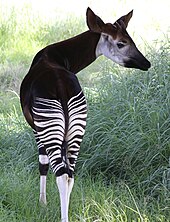
Male person okapi displaying his hitting horizontal stripes
The okapi is a medium-sized giraffid, continuing i.5 yard (4 ft 11 in) tall at the shoulder. Its boilerplate torso length is about two.5 m (8 ft ii in) and its weight ranges from 200 to 350 kg (440 to 770 lb).[21] It has a long cervix, and large and flexible ears. In abrupt contrast to the white horizontal stripes on the legs and white ankles, the okapi's coat is a chocolate to cherry brown. The distinctive stripes resemble those of a zebra.[22] These features serve as an effective cover-up amidst dumbo vegetation. The face, throat, and chest are greyish white. Interdigital glands are present on all four feet, and are slightly larger on the front feet.[23] Male person okapis accept short, hair-covered horn-like structures called ossicones, less than 15 cm (v.9 in) in length, which are similar in class and part to the ossicones of a giraffe.[24] The okapi exhibits sexual dimorphism, with females 4.2 cm (ane.7 in) taller on average, slightly redder, and lacking prominent ossicones, instead possessing pilus whorls.[25] [26]
The okapi shows several adaptations to its tropical habitat. The large number of rod cells in the retina facilitate night vision, and an efficient olfactory system is present. The big auditory bullae of the temporal os allow a potent sense of hearing. The dental formula of the okapi is 0.0.3.iii three.1.3.iii .[23] Teeth are low-crowned and finely cusped, and efficiently cut tender foliage. The large cecum and colon assistance in microbial digestion, and a quick rate of food passage allows for lower cell wall digestion than in other ruminants.[27]

The okapi is easily distinguished from its nearest extant relative, the giraffe. It is much smaller than the giraffe and shares more external similarities with bovids and cervids. Ossicones are present only in the male person okapi, while both sexes of giraffe possess this feature. The okapi has large palatine sinuses (hollow cavities in the palate), unique amidst the giraffids. Morphological features shared between the giraffe and the okapi include a similar gait – both use a pacing gait, stepping simultaneously with the front and the hind leg on the same side of the body, different other ungulates that walk past moving alternate legs on either side of the body[28] – and a long, blackness tongue (longer in the okapi) useful for plucking buds and leaves, too as for grooming.[27]
Environmental and behaviour [edit]
Okapis are primarily diurnal, but may be active for a few hours in darkness.[29] They are essentially solitary, coming together only to breed. They have overlapping home ranges and typically occur at densities around 0.half-dozen animals per square kilometre.[22] Male home ranges average thirteen km2 (5.0 sq mi), while female home ranges average 3–5 kmtwo (ane.ii–1.nine sq mi). Males drift continuously, while females are sedentary.[thirty] Males ofttimes mark territories and bushes with their urine, while females use common defecation sites. Grooming is a common practice, focused at the earlobes and the neck. Okapis often rub their necks against copse, leaving a brown exudate.[23]
The male is protective of his territory, but allows females to pass through the domain to forage. Males visit female domicile ranges at breeding fourth dimension.[27] Although generally tranquil, the okapi can kick and barrel with its head to show assailment. As the vocal cords are poorly developed, vocal communication is mainly restricted to three sounds — "chuff" (contact calls used by both sexes), "moan" (by females during courtship) and "squeal" (by infants under stress). Individuals may engage in Flehmen response, a visual expression in which the animate being curls back its upper lips, displays the teeth, and inhales through the rima oris for a few seconds. The leopard is the main natural predator of the okapi.[23]
Diet [edit]

The long tongue of the okapi
Okapis are herbivores, feeding on tree leaves and buds, grasses, ferns, fruits, and fungi. They are unique in the Ituri Forest every bit they are the but known mammal that feeds solely on understory vegetation, where they use their eighteen-inch-long (46 cm) tongues to selectively browse for suitable plants. The tongue is also used to groom their ears and eyes.[31] They prefer to feed in treefall gaps. The okapi has been known to feed on over 100 species of plants, some of which are known to be poisonous to humans and other animals. Fecal assay shows that none of those 100 species dominates the diet of the okapi. Staple foods comprise shrubs and lianas. The main constituents of the nutrition are woody, dicotyledonous species; monocotyledonous plants are non eaten regularly. In the Ituri woods, the okapi feeds mainly upon the plant families Acanthaceae, Ebenaceae, Euphorbiaceae, Flacourtiaceae, Loganiaceae, Rubiaceae, and Violaceae.[23] [30]
Reproduction [edit]
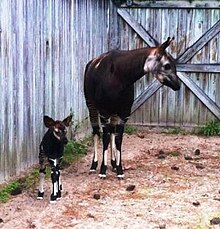
A female okapi with her calf at White Oak Conservation
Female okapis become sexually mature at about one-and-a-one-half years old, while males accomplish maturity later on ii years. Heat in males and estrous in females does not depend on the season. In captivity, estrous cycles recur every 15 days.[27] [32] The male person and the female begin courtship by circling, smelling, and licking each other. The male shows his interest by extending his neck, tossing his head, and protruding one leg forrad. This is followed by mounting and copulation.[25]
The gestational menses is around 440 to 450 days long, following which usually a single calf is born, weighing xiv–thirty kg (31–66 lb). The udder of the pregnant female starts swelling 2 months earlier parturition, and vulval discharges may occur. Parturition takes iii–4 hours, and the female stands throughout this period, though she may rest during cursory intervals. The mother consumes the afterbirth and extensively grooms the infant. Her milk is very rich in proteins and depression in fatty.[27]
As in other ruminants, the baby tin can stand inside 30 minutes of nativity. Although generally similar to adults, newborn calves have long hairs around the eye (resembling false eyelashes), a long dorsal mane, and long white hairs in the stripes.[33] These features gradually disappear and requite way to the general appearance within a year. The juveniles are kept in hiding, and nursing takes place infrequently. Calves are known not to defecate for the offset month or two of life, which is hypothesized to help avoid predator detection in their most vulnerable stage of life.[34] The growth rate of calves is appreciably high in the showtime few months of life, afterwards which information technology gradually declines. Juveniles start taking solid food from 3 months, and weaning takes place at 6 months. Ossicone development in males takes ane yr after nascence. The okapi'south typical lifespan is xx–30 years.[23]
Distribution and habitat [edit]
The okapi is endemic to the Democratic Congo-brazzaville, where information technology occurs n and east of the Congo River. It ranges from the Maiko National Park northward to the Ituri rainforest, then through the river basins of the Rubi, Lake Tele, and Ebola to the west and the Ubangi River farther north. Smaller populations exist west and south of the Congo River. It is also common in the Wamba and Epulu areas. It is extinct in Uganda.[1]
The okapi inhabits canopy forests at altitudes of 500–1,500 m (1,600–4,900 ft). It occasionally uses seasonally inundated areas, merely does not occur in gallery forests, swamp forests, and habitats disturbed by homo settlements. In the wet season, it visits rocky inselbergs that offer forage uncommon elsewhere. Results of research conducted in the tardily 1980s in a mixed Cynometra forest indicated that the okapi population density averaged 0.53 animals per square kilometre.[30]
In 2008, it was recorded in Virunga National Park.[35]
There is prove that okapis were also observed in the Semuliki Valley in Uganda by Europeans, merely later became extinct in the late 1970s.[36] The Semuliki Valley provides a similar habitat to the Congo Basin.
Status [edit]
Threats and conservation [edit]
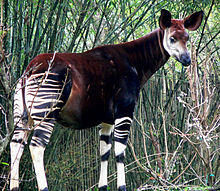
The IUCN classifies the okapi equally endangered.[37] Information technology is fully protected under Congolese law. The Okapi Wildlife Reserve and Maiko National Park support significant populations of the okapi, though a steady decline in numbers has occurred due to several threats. Other areas of occurrence are the Rubi Tele Hunting Reserve and the Abumombanzi Reserve. Major threats include habitat loss due to logging and man settlement. Extensive hunting for bushmeat and skin and illegal mining accept besides led to population declines. A threat that has emerged quite recently is the presence of illegal armed groups around protected areas, inhibiting conservation and monitoring deportment. A small population occurs north of the Virunga National Park, but lacks protection due to the presence of armed groups in the vicinity.[1] In June 2012, a gang of poachers attacked the headquarters of the Okapi Biological reserve, killing half dozen guards and other staff[38] as well every bit all 14 okapis at their breeding center.[39]
The Okapi Conservation Project, established in 1987, works towards the conservation of the okapi, besides as the growth of the indigenous Mbuti people.[1] In Nov 2011, the White Oak Conservation center and Jacksonville Zoo and Gardens hosted an international meeting of the Okapi Species Survival Plan and the Okapi European Endangered Species Programme at Jacksonville, which was attended past representatives from zoos from the U.s.a., Europe, and Japan. The aim was to discuss the management of captive okapis and arrange back up for okapi conservation. Many zoos in Northward America and Europe currently have okapis in captivity.[twoscore]
Okapis in zoos [edit]
Effectually 100 okapis are in accredited Association of Zoos and Aquariums (AZA) zoos. The okapi population is managed in America by the AZA's Species Survival Plan, a breeding program that works to ensure genetic diversity in the captive population of endangered animals, while the EEP (European studbook) and ISB (Global studbook) are managed by Antwerp Zoo in Kingdom of belgium, which was the first zoo to have an Okapi on display (in 1919), as well as one of the most successful in breeding them.[41] [42]
In 1937, the Bronx Zoo became the starting time in Northward America to acquire an okapi.[43] With one of the most successful convenance programs, 13 calves take been born there since 1991.[44] The San Diego Zoo has exhibited okapis since 1956, and their starting time okapi calf was born in 1962.[45] Since then, at that place have been more than 60 okapis born at the zoo and the nearby San Diego Zoo Safari Park, the virtually recent being Mosi, a male person calf born on 21 July 2017 at the zoo.[46] The Brookfield Zoo in Chicago has also greatly contributed to the captive population of okapis in accredited zoos. The zoo has had 28 okapi births since 1959.[47]
Other North American zoos that showroom and breed okapis include: Denver Zoo and Cheyenne Mountain Zoo (Colorado); Houston Zoo, Dallas Zoo, and San Antonio Zoo (Texas); Disney's Animal Kingdom, White Oak Conservation, Zoo Miami, and ZooTampa at Lowry Park (Florida); Los Angeles Zoo and Sacramento Zoo (California); Saint Louis Zoo (Missouri); Cincinnati Zoo and Botanical Garden and Columbus Zoo and Aquarium (Ohio); Memphis Zoo and Nashville Zoo (Tennessee); The Maryland Zoo in Baltimore (Maryland); Sedgwick County Zoo and Tanganyika Wildlife Park (Kansas); Roosevelt Park Zoo[48] (North Dakota); Henry Doorly Zoo and Aquarium (Nebraska); Philadelphia Zoo (Pennsylvania); Potawatomi Zoo[49] (Indiana); Oklahoma Urban center Zoo and Botanical Garden (Oklahoma); and Blank Park Zoo (Iowa).[l]
In Europe, zoos that exhibit and breed okapis include: Chester Zoo, London Zoo, Marwell Zoo, The Wild Place,[51] and Yorkshire Wildlife Park[52] (United Kingdom); Dublin Zoo (Ireland); Berlin Zoo, Frankfurt Zoo, Wilhelma Zoo, Wuppertal Zoo, Cologne Zoo, and Leipzig Zoo (Germany); Zoo Basel (Switzerland); Copenhagen Zoo (Denmark); Rotterdam Zoo and Safaripark Beekse Bergen (Netherlands); Dvůr Králové Zoo (Czechia); Wrocław Zoo (Poland); Bioparc Zoo de Doué and ZooParc de Beauval (France); and Lisbon Zoo (Portugal).[53]
In Asia, three Japanese zoos exhibit okapis: Ueno Zoo in Tokyo; Kanazawa Zoo and Zoorasia in Yokohama.[54]
References [edit]
- ^ a b c d Mallon, D.; Kümpel, N.; Quinn, A.; Shurter, S.; Lukas, J.; Hart, J.A.; Mapilanga, J.; Beyers, R.; Maisels, F. (2015). "Okapia johnstoni". IUCN Red Listing of Threatened Species. 2015: e.T15188A51140517. doi:ten.2305/IUCN.United kingdom.2015-4.RLTS.T15188A51140517.en . Retrieved xix November 2021.
- ^ The Oriental Establish of the University of Chicago, Photographic Archives; photo detail. The Oriental Found identifies the subject every bit an Okapi with a question mark.
- ^ "Start pictures of the okapi or the African 'unicorn'". ZME Scientific discipline. 12 September 2008. Retrieved 20 February 2020.
- ^ "A New Bargain for the Okapi, Africa'southward "Unicorn"". NRDC . Retrieved 20 Feb 2020.
- ^ "New hope for the elusive okapi, Congo'due south mini giraffe". Earth Touch News Network . Retrieved 9 November 2017.
- ^ a b Nowak, Ronald Thousand. (1999) Walker's Mammals of the Globe. 6th ed. p. 1085.
- ^ Sclater, Philip Lutley (1901). "On an Patently New Species of Zebra from the Semliki Forest". Proceedings of the Zoological Lodge of London. 1: 50–52 – via Biodiversity Heritage Library.
- ^ "okapi, n." Oxford English Dictionary . Retrieved 3 Apr 2020.
- ^ Lindsey, Susan Lyndaker; Dark-green, Mary Neel; Bennett, Cynthia 50. (1999), The Okapi: Mysterious Brute of Congo-Zaire, University of Texas Press, pp. iv–8, ISBN0292747071
- ^ "Proceedings of the full general meetings for scientific business of the Zoological Gild of London". Proceedings of the Zoological Society of London. 2 (1): i–5. 1901. (May to December)
- ^ Kingdon, Jonathan (1979). Eastward African Mammals: An Atlas of Development in Africa, Volume 3, Part B. Chicago: University of Chicago Press. p. 339. ISBN9780226437224.
- ^ a b Prothero, Donald R.; Schoch, Robert M. (2002). Horns, tusks, and flippers : the development of hoofed mammals. Baltimore, Physician.: Johns Hopkins University Press. pp. 66–67. ISBN9780801871351.
- ^ Bohlin, B. (1926). "Dice Familie Giraffidae: mit besonderer Berücksichtigung der fossilen Formen aus China". Palaeontologica Sinica, Serial C. 4: 1–179.
- ^ Colbert, Eastward. H. (February 1938). "The relationships of the okapi". Journal of Mammalogy. nineteen (ane): 47–64. doi:10.2307/1374281. JSTOR 1374281.
- ^ Geraads, Denis (January 1986). "Remarques sur la systématique et la phylogénie des Giraffidae (Artiodactyla, Mammalia)". Geobios. xix (4): 465–477. doi:10.1016/S0016-6995(86)80004-three.
- ^ Finlayson, Clive (2009). Neanderthals and Mod Humans : An Ecological and Evolutionary Perspective (Digitally printed ed.). Cambridge: Cambridge University Press. p. 25. ISBN978-0521121002.
- ^ Hunt, Kathleen. "Transitional Vertebrate Fossils FAQ Role 2C". TalkOrigins. Retrieved 28 Apr 2015.
- ^ Mitchell, G.; Skinner, J. D. (2003). "On the origin, evolution and phylogeny of giraffes Giraffa camelopardalis". Transactions of the Royal Lodge of South Africa. 58 (one): 51–73. doi:x.1080/00359190309519935. S2CID 6522531.
- ^ "Why Is the Okapi Called a Living Fossil". The Milwaukee Journal. 24 June 1954.
- ^ Agaba, G.; Ishengoma, E.; Miller, Due west. C.; McGrath, B. C.; Hudson, C. Due north.; Bedoya Reina, O. C.; Ratan, A.; Burhans, R.; Chikhi, R.; Medvedev, P.; Praul, C. A.; Wu-Cavener, 50.; Wood, B.; Robertson, H.; Penfold, L.; Cavener, D. R. (May 2016). "Giraffe genome sequence reveals clues to its unique morphology and physiology". Nature. 7: 11519. Bibcode:2016NatCo...711519A. doi:10.1038/ncomms11519. PMC4873664. PMID 27187213.
- ^ Burnie & Don E. Wilson (2001). Creature (1st American ed.). New York: DK. ISBN0789477645.
- ^ a b Palkovacs, E. "Okapi Okapia johnstoni". Animal Diversity Web. University of Michigan Museum of Zoology. Retrieved 17 Apr 2015.
- ^ a b c d e f Bodmer, R. E.; Rabb, 1000. B. (10 December 1992). "Okapia johnstoni" (PDF). Mammalian Species (422): 1–eight. doi:10.2307/3504153. JSTOR 3504153. Archived from the original (PDF) on 24 September 2015.
- ^ Nasoori, Alireza (2020). "Germination, construction, and office of actress‐skeletal basic in mammals". Biological Reviews. 95 (4): 986–1019. doi:x.1111/brv.12597. PMID 32338826. S2CID 216556342.
- ^ a b Grzimek, B. (1990). Grzimek's Encyclopedia of Mammals (Book v). New York: McGraw-Colina Publishing Visitor.
- ^ Solounias, N. (Nov 1988). "Prevalence of ossicones in Giraffidae (Artiodactyla, Mammalia)". Periodical of Mammalogy. 69 (4): 845–8. doi:10.2307/1381645. JSTOR 1381645.
- ^ a b c d e Kingdon, Jonathan (2013). Mammals of Africa (1st ed.). London: A. & C. Black. pp. 95–115. ISBN978-one-4081-2251-8.
- ^ Dagg, A. I. (May 1960). "Gaits of the Giraffe and Okapi". Journal of Mammalogy. 41 (ii): 282. doi:10.2307/1376381. JSTOR 1376381.
- ^ Lusenge, T.; Nixon, S. (2008). "Conservation status of okapi in Virunga National Park". ZSL Conservation Report. Zoological Society of London.
- ^ a b c Hart, J. A.; Hart, T. B. (1989). "Ranging and feeding behaviour of okapi (Okapia johnstoni) in the Ituri Forest of Zaire: nutrient limitation in a pelting-wood plant eater". Symposium of the Zoological Society of London. 61: 31–fifty.
- ^ "Okapi Conservation Strategy and Condition Review" (PDF). world wide web.giraffidsg.org. 21 February 2018. Archived from the original (PDF) on 21 February 2018. Retrieved 21 Feb 2018.
- ^ Schwarzenberger, F.; Rietschel, Westward.; Matern, B.; Schaftenaar, W.; Bircher, P.; van Puijenbroeck, B.; Leus, K. (December 1999). "Noninvasive reproductive monitoring in the okapi (Okapia johnstoni)". Journal of Zoo and Wildlife Medicine. The American Association of Zoo Veterinarians. thirty (iv): 497–503. PMID 10749434.
- ^ Jirik, Kate. "Okapia johnstoni Fact Sheet". ielc.libguides.com. San Diego Zoo Wild animals Alliance. Retrieved 28 Baronial 2021.
- ^ "Rare okapi born in Rotterdam Zoo". Rotterdam Zoo. 2 September 2019. Retrieved 20 February 2020.
- ^ Nixon, S. C.; Lusenge, T. (2008). Conservation status of okapi in Virunga National Park, Democratic Democracy of Congo. ZSL Conservation Report No. 9 (PDF). London: The Zoological Society of London.
- ^ Sever, Zvi (3 October 2020). "Searching for the okapi (Okapia johnstoni) in Semuliki National Park, Republic of uganda". African Periodical of Ecology. 59 (1): 286–292. doi:x.1111/aje.12796. S2CID 224839859. Retrieved 26 March 2021.
- ^ Hebert, Amanda (26 November 2013). "Okapi Added to IUCN'South Endangered Species List". Jacksonville, Florida: Okapi Conservation Project. Retrieved 3 June 2014.
- ^ Flocken, J. (29 June 2012). "Tragic Losses in the Heart of Darkness". HuffPost. Retrieved xviii Apr 2015.
- ^ Jones, P. (3 April 2013). "Infamous elephant poacher turns cannibal in the Congo". Mongabay. Retrieved sixteen July 2017.
- ^ "Okapi SSP and EEP International Meeting". Okapi Conservation Project. Wildlife Conservation Global. Retrieved xviii April 2015.
- ^ "Of okapis and men: Antwerp Zoo helps preserve endangered species". Flanders Today. 12 Baronial 2016. Archived from the original on 14 August 2016. Retrieved 27 May 2018.
- ^ "Okapi'due south Half-Century" (PDF). Zooquaria. EAZA (85): 7. Spring 2014. Retrieved 23 February 2021.
- ^ "Bronx Zoo Debuts Its Baby Okapi". WCSNewsroom. 27 July 2009. Retrieved nineteen October 2018.
- ^ "Baby Okapi Makes Public Debut At Bronx Zoo". newyork.cbslocal.com. viii November 2011. Retrieved 19 Oct 2018.
- ^ "Animals & Plants | Okapi". animals.sandiegozoo.org . Retrieved 4 October 2017.
- ^ Peterson, Karla (23 August 2017). "Endangered okapi born at San Diego Zoo". The San Diego Spousal relationship-Tribune . Retrieved 23 February 2021.
- ^ "Brookfield Zoo Celebrates Its 28th Okapi Birth Since 1959". chicago.cbslocal.com. 26 May 2017. Retrieved iv October 2017.
- ^ "Okapi arrives at Roosevelt Park Zoo". Minot Daily News. 15 September 2017. Archived from the original on 6 August 2020. Retrieved xviii May 2020.
- ^ "Okapi".
- ^ "Okapi Conservation Project | The Americas". okapiconservation.org . Retrieved 13 May 2019.
- ^ "Helping to protect endangered species around the world". Bristol Zoo. 17 May 2019. Retrieved 23 February 2021.
- ^ "Rare Okapi Arrive at Yorkshire Wild fauna Park". Yorkshire Wildlife Park. 17 May 2018. Retrieved 23 February 2021.
- ^ "Okapi Conservation Project | Europe". okapiconservation.org . Retrieved 25 November 2017.
- ^ "Okapi Conservation Projection | Asia". okapiconservation.org . Retrieved thirteen May 2019.
Further reading [edit]
- Wolfram Bong (November. 2009): Okapis: geheimnisvolle Urwaldgiraffen; Entdeckungsgeschichte, Biologie, Haltung und Medizin einer seltenen Tierart. Schüling Verlag Münster, Germany. ISBN 978-3-86523-144-4.
- Zvi Sever, Searching for the okapi (Okapia johnstoni) in Semuliki National Park, Republic of uganda. Afr. J. Ecol. Vol. 00: 1–7. doi:10.1111/aje.12796
External links [edit]
| | Look upwardly okapi in Wiktionary, the free dictionary. |
- The okapi direction site
- Monograph of the Okapi (1910) by E. Ray Lankester and William George Ridewood
- . Encyclopædia Britannica (11th ed.). 1911.
Source: https://en.wikipedia.org/wiki/Okapi

0 Response to "what is the closest relative to a giraffe"
Publicar un comentario